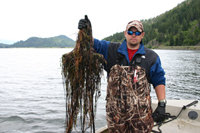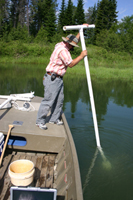GRI Researchers Partner with Idaho, Bonner County to Survey Weeds
August 9, 2007Assistant professor John Madsen and a team of student researchers are spending much of the summer researching Eurasian watermilfoil in northern Idaho.
 The team received a grant from Bonner County to survey Lake Pend Oreille, the largest lake in Idaho. Bonner County got the grant money from Idaho State Department of Agriculture to control or eradicate the invasive species from Lake Pend Oreille. The final partner in the group is the Aquatic Ecosystem Restoration Foundation.
The team received a grant from Bonner County to survey Lake Pend Oreille, the largest lake in Idaho. Bonner County got the grant money from Idaho State Department of Agriculture to control or eradicate the invasive species from Lake Pend Oreille. The final partner in the group is the Aquatic Ecosystem Restoration Foundation.Madsen's team is using a variety of survey methods for two goals. In order to find places in the lake with the invasive plant, they spent mid-May through June surveying the entire lake. In this survey, the team used a Global Positioning System to measure every 255 meters in a grid system to regularly collect data. This survey is being repeated to see if there are any new colonies.
 The other two survey methods are to determine the efficacy of the treatments. In places where they found the invasive species, they conducted another GPS survey, but on a smaller grid. Soon, those areas will be surveyed again, three or four weeks after the management, mechanical or chemical, has begun.
The other two survey methods are to determine the efficacy of the treatments. In places where they found the invasive species, they conducted another GPS survey, but on a smaller grid. Soon, those areas will be surveyed again, three or four weeks after the management, mechanical or chemical, has begun.Finally, in ten sites, they are using biomass sampling. They will take 30 samples using a bazooka-like device that acts like an apple corer that they have developed. Biomass sampling is the most definitive method to determining the abundance of plants. The ten sites have been treated with Renovate or Fluridone, two chemical herbicides, or by diver-controlled suction harvesting, a mechanical method. The biomass sampling is time- and labor-intensive, but it will allow the researchers to determine what is the most effective means of management. For more information about the Lake Pend Oreille project, please contact John Madsen, Ph.D. at jmadsen@gri.msstate.edu.
